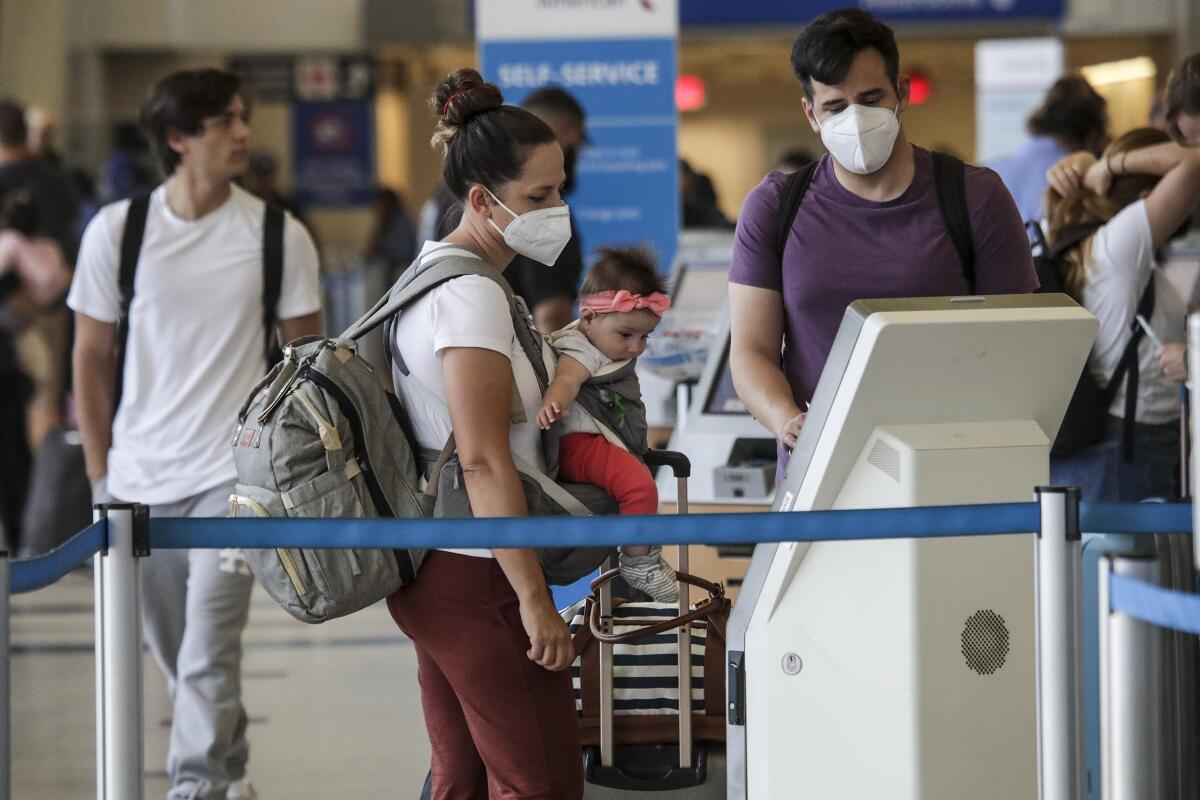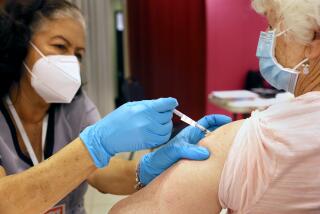Super-infectious BA.4, BA.5 push L.A. coronavirus cases to highest levels in 5 months

Los Angeles County’s coronavirus case rate hit its highest point in nearly five months over the Fourth of July holiday weekend, a troubling sign of how two new super-infectious Omicron strains are creating conditions for a fraught summer.
Two Omicron subvariants, BA.4 and BA.5, have become dominant nationwide, and they appear to be among the most contagious yet of this pandemic.
Coronavirus case rates have also been increasing statewide, with the San Francisco Bay Area reporting California’s highest rate. Hospitalizations have also been creeping up, but hospitals haven’t reported being overwhelmed. Still, experts are concerned the next weeks could see more rapid spread that would put new pressures on the healthcare system.
“Right now, if we go up more, it is going to get into a little bit more of a danger zone with hospitalizations,” with a potential to strain the healthcare system, said Dr. Peter Chin-Hong, a UC San Francisco infectious-disease expert.
Too many coronavirus-positive patients can impact hospital operations, even if they’re being treated for non-COVID-19 reasons, because of the resources needed to isolate them, Chin-Hong said.
One of the biggest concerns about BA.4 and BA.5 is that people can get reinfected even after suffering from an earlier Omicron subvariant. Dr. Robert Wachter, chair of UC San Francisco’s Department of Medicine, wrote that this could mean elevated infection levels through the summer and into the fall.
“Beyond that, much depends on whether a new variant emerges to supplant it. Given the pattern of the past year, it would be foolish to bet against that,” he wrote over the weekend.
The rise of the latest subvariant, BA.5, he added, is particularly notable because “prior infection — including an Omicron infection as recent as last month — no longer provides robust protection from reinfection.”
“We’re seeing such folks get reinfected within one to two months,” he added.
Vaccinations and boosters remain “hugely valuable in preventing a severe case that might lead to hospital/death,” Wachter wrote. “But its value in preventing a case of COVID, or preventing transmission, is now far less than it once was.”
The increasing dominance of Omicron subvariants BA.4 and BA.5 could put L.A. County, the nation’s most populous county, even closer to reinstating a universal mask order for indoor public spaces perhaps later this month or next month if trends hold.
Experts are urging people to get up-to-date on their vaccinations, and that includes getting a first booster shot, or a second booster if eligible. Vaccinations and booster shots have been key factors in keeping hospitalizations relatively modest for now.
Don’t wait for an Omicron-specific booster, they said, since its rollout will likely be delayed until November to incorporate a vaccination formula designed against the more recent Omicron subvariants, rather than the oldest version, which scientists fear would be relatively obsolete by then.
“My advice is to go ahead and get” a booster now, Chin-Hong said. There remain questions about exactly how available the autumn Omicron-specific booster will be, considering that Congress has not yet approved billions of dollars needed for pandemic-control efforts, including money to pre-order vaccinations.
If federal officials are still hamstrung by limited funds later this year, the autumn Omicron-specific vaccination may “only be available for a limited group of people,” perhaps only for those age 65 and over, Chin-Hong said.
“I don’t know what’s going to happen in November. And we do know that BA.4 and BA.5 is starting to rage right now. So you might as well go and protect yourself against what we know,” Chin-Hong said.
Anecdotally, some residents are describing substantial discomfort with recent COVID-19 illness, even if they’re not hospitalized. “My heart rate was so high,” wrote one commenter on Reddit, with others describing their children suffering fevers hitting 104 degrees.
“It’s either chills where you are shivering and need a blanket, to sweating under the blanket,” wrote another commenter. “The sore throat is like shards of crushed glass every single time you swallow,” a third wrote.
“It’s very unpleasant for many people,” Chin-Hong said. He said a colleague of his likely got infected from her children, and during her acute illness, “she couldn’t multitask anymore ... for a time, she was sort of at wit’s end not feeling normal for quite a few weeks.”
Long COVID, in which symptoms like brain fog and fatigue can last for months or years, is also a risk after contracting COVID-19, even among people who are vaccinated and boosted.
Eighty percent of L.A. County residents have completed their primary vaccination series, but there are still many vaccinated people who haven’t received a single booster shot. Among those age 5 and up eligible for at least one booster, 56% have received one.
Among L.A. County residents age 50 and up eligible for a second booster shot, only 33% have received it.
The U.S. Centers for Disease Control and Prevention says everyone age 5 and up should get one booster shot. Those age 50 and up, and some people age 12 and up with weakened immune systems, should get a second booster shot, the CDC says.
Among vaccinated people, those who haven’t received a booster shot are more likely to need hospitalization, Chin-Hong said.
Doctors are also warning that simply relying on vaccinations alone is not enough to guard against infection, and health officials are strongly recommending mask use in indoor public settings.
“The increase in positive cases among fully vaccinated individuals does likely reflect the dominance of newer Omicron subvariants that both spread more easily and are able to evade some of the vaccine protection against infections,” L.A. County Public Health Director Barbara Ferrer said last week.
Unvaccinated people age 5 and up were just one-and-a-half times as likely to test positive for the coronavirus than vaccinated people — a group that includes those who got boosted and didn’t get boosted — for the 14-day period that ended June 9, Ferrer said.
By contrast, half a year ago, unvaccinated people were about three-and-a-half times as likely to test positive for the coronavirus compared to vaccinated-but-not-boosted people, according to L.A. County data for the weekly period that ended Dec. 4.
Protection against being hospitalized is still substantial for the vaccinated, but it has also weakened over time. Half a year ago, an unvaccinated person was 13 times as likely to be hospitalized with a coronavirus infection than a vaccinated person. Now, an unvaccinated person is almost 4 times as likely to be hospitalized.
For deaths, half a year ago, an unvaccinated person was 17 times as likely to die from COVID-19; now, an unvaccinated person is 8 times as likely to die.
Despite the reduction in effectiveness, “the approved FDA vaccines are in fact doing exactly what we need them to do. They’re preventing severe illness and death,” Ferrer said.
Put another way, of the nearly 7 million L.A. County residents who have completed their primary vaccination series, about 13% have tested positive in results sent to government officials, 0.2% have been hospitalized and 0.03% have died.
Many people are now getting their positive test results from at-home test kits whose results aren’t reported to officials. But “even if we’re doubling this number — so that we can account for those who tested using over-the-counter test kits — many fully vaccinated people have not yet been infected,” Ferrer said.
There has been some debate as to whether younger adults should be made eligible for a second booster shot now. Ferrer has been among those asking the U.S. Food and Drug Administration to conduct a new review of data to reconsider allowing more people to get a second booster sooner.
Chin-Hong is among the experts who thinks opening up the eligibility to a second booster makes sense.
“At the minimum, it will kind of bolster people’s antibodies, even though” the boosters are not specifically designed to target BA.4 and BA.5, Chin-Hong said. “To me, it will be more convenient to just liberalize it to everyone.”
But federal officials have not signaled they are prepared imminently to widen availability of the second booster to those under age 50 who aren’t immunocompromised.
On the Fourth of July, Los Angeles County recorded an average of about 5,500 coronavirus cases a day over the prior week, the highest such figure since early February, when the first Omicron surge was fading. On a per capita basis, that was equal to 383 cases a week for every 100,000 residents; a rate of 100 or more cases a week for every 100,000 residents is considered high.
By Tuesday, the case rate declined slightly to 376 cases a week for every 100,000 residents, but that likely was a result of delayed reporting over the holiday weekend. The latest case rate was still 9% higher than it was the prior week.
Last week, L.A. County recorded its highest weekly rate of new coronavirus-positive hospitalizations since February — 8.3 hospitalizations for every 100,000 residents, up from 7.3 for the prior week. If that rate hits 10 or more for two consecutive weeks, L.A. County health officials plan to impose a new universal mask mandate in indoor public settings for everyone age 2 and up.
The mandate would remain until the rate falls below that threshold for two consecutive weeks.
The Omicron subvariants BA.4 and BA.5 comprised an estimated 70.1% of new cases nationwide for the weeklong period that ended Saturday, according to the CDC. This completes a stunning rise to dominance for the duo of subvariants, which only a month earlier was thought to be responsible for a bit less than 16% of new cases.
Omicron has spawned a number of subvariants since emerging late last fall, and those have largely been characterized by ramped-up infectivity. But “BA.5 is a different beast with a new superpower: Enough alteration in the spike protein that immunity from either prior vax or prior Omicron infection (including recent infection) doesn’t offer much protection,” according to Wachter.
“As BA.5 becomes the dominant U.S. variant, its behavior will determine our fate for the next few months, until it either burns itself out by infecting so many people or is replaced by a variant that’s even better at infecting people,” Wachter wrote on Twitter. “Neither is a joyful scenario.”
More to Read
Start your day right
Sign up for Essential California for news, features and recommendations from the L.A. Times and beyond in your inbox six days a week.
You may occasionally receive promotional content from the Los Angeles Times.








